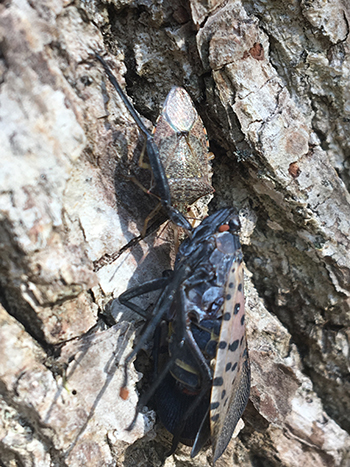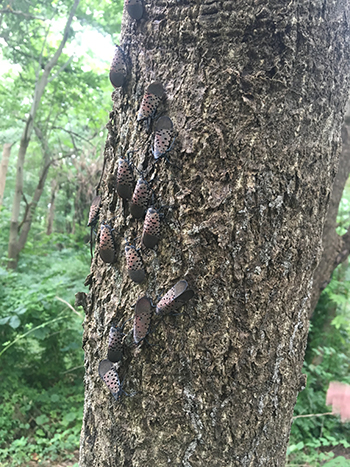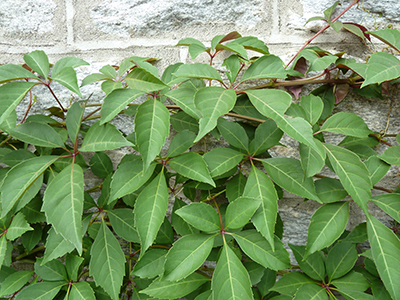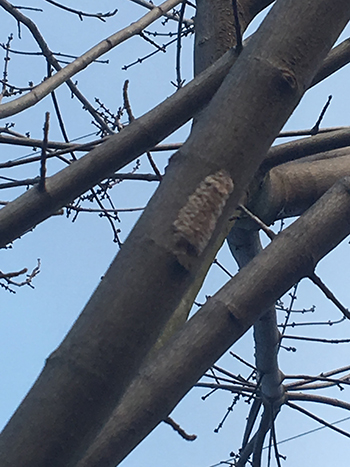
An FYI on the Spotted Lanternfly
Guest Author: Kayonna Tindle, student garden coordinator

Spotted lanternfly adults are red and black with black spots. photo credit: L. Rasmussen
What is a spotted lanternfly?
The spotted lanternfly or Lycorma delicatula is an invasive arthropod species of the planthopper family. These insects undergo four instar stages as nymphs before reaching the adult stage. While the nymphs of Lycorma delicatula have a black exoskeleton with white spots and share the appearance of small spiders or ticks, the adults are red and black with black spots. Despite having wings in the adult stage, Lycorma delicatula are primarily hoppers and crawlers.

Despite having wings in the adult stage, Lycorma delicatula are primarily hoppers and crawlers. photo credit: L. Rasmussen
The spotted lantern fly prefers the “tree of heaven” (Ailanthus altissima), but these insects have been found to feed on a variety of 25 tree species in the state of Pennsylvania alone. The egg masses are laid on smooth bark, stems, and other flat surfaces and resemble grey putty. Each cluster protects as many as 50 eggs. The insects laying ritual occurs in the fall and early winter.

When you find a spotted lanternfly squash the pest. photo credit: R. Robert
Are they dangerous?
Although these invasive arthropods are not known to be a direct danger to humans and pets, they are certainly a serious pest to some food crops and several tree populations. Rather than outright killing the trees themselves, the Spotted Lanternfly feed on them leaving open lesions from which tree sap will flow and attract other insects. The sugary substance the insects excretes while eating is called honeydew which drips down to branches below and is the cause of sooty mold development, which ultimately weakens the tree. It is disconcerting that these insects may gravely impact tree nurseries as well as crop yields from fruit trees, grapes, soybean, and corn if this infestation continues to spread unchecked.

The Scott Arboretum gardeners are herding the spotted lanternfly to a “trap” tree. photo credit: S. MacQueen
What are we doing about them here at Scott?
Since the Scott Arboretum (along with the rest of Swarthmore and Delaware County) is in the quarantine zone, we support the method of herding the pest population to “trap” trees. This is done through selective destruction of female (and some male) Ailanthus altissima trees and applying a systemic herbicide to inhibit sucker sprouting. The trap trees are then treated with an insecticide for a mass extermination of the local pest population in the area.

Parthenocissus henryana is a favorite of the spotted lanternfly. photo credit: J. Coceano
Trends in the Delaware Valley
We have observed that the pest likes Parthenocissus and all plants in the grape family, Vitaceae, in general. We have been herding the lanternflies to our native Virginia creeper (Parthenocissus) to use as a “trap” tree.

Egg masses should be scrapped off surfaces. photo credit: L. Rasmussen
What do I do when I see one or many?
If you find a bug, simple squish the pest. They are hopping insects and thus easy to catch. During this time of year, you will find egg masses, which should be scraped off and disposed of. Please do not broadly apply pesticides to control this pest. Consider using sticky pads on targeted plants to trap this pest.
Get answers to all your question at our info session “Tips for Dealing with Spotted Lanternflies” on Tuesday, December 10, 2019 from 7 to 8:30 pm.
For more reference please see





No Comments